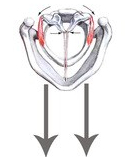What kind of warm-up do you do before your personal rehearsal time or general choral rehearsal warm-up? Of course, warm-ups may vary depending on the time of day you begin singing, your gender and age and what kind of singing you are about to do.
What are your default “must-do” warm-ups?
Here’s what our top vocal pedagogues, performers, & educators said ~
clarification: Lip buzzes are lip trills. Penta-scales are five note scales.
All of our vocal pedagogues had two exercises in common:
1) Use of lip buzzes or lip trills and slides (penta-scale to an octave + 1)
2) slides or glissando as a semi-occluded vocal tract exercise for breathe motion, ease of use of vocal folds, and the thinning of them.
1. Jamea Sale: Vocal Coach, Singer, Private Instructor. http://www.jameasale.com/
- Yawn-sighs and puppy dog whines into descending slides on the penta-scale with neutral vowel.
- Ascending flex lip trills high to low [V15 exercise].

- Yoo-ah flexibility using skips and leaps [V14 exercise].

2. Anonymous, Professional Baritone/ Private Instructor.
As a vocal warm up, I’m more interested in stretching other muscles, relaxing and resting my voice, and eating a meal with protein about two hours before performing. Singing with regularity doesn’t require that much time to warm up. That being said . . .
- I use coffee stirrers, often two at a time, one if I’m feeling bold. Singing through straws emphasizes feeling your voice rather than listening to yourself helps avoid pushing too much air. Quick scales that span an octave and a half or two octaves.
- Continue with the semi-occluded vocal tract idea singing voiced consonants in the mid-range. “Th” is great as in “the” because it naturally fronts the tongue. It’s important to maintain an open pharynx/stable larynx while your mouth is closed.
- Classic coloratura warm ups on [i-e-a-o-u] moving quickly through penta-scales and nine scales. Low range to high, aiming to sing three half-steps below and above the range I’ll need to sing during that day’s performance.
Vocal Folds stretch during octave slides:

3. Anonymous, Professional Lyric Soprano / Private Instructor.
- Lip trills using the penta-scale ascending and descending.
- Repeat scales on 16th notes ascending and descending on one breath for at least 10 counts with the last note being a half note to prep air for the next repetition.
- Range scales with full extensions as high and as low as one can sing with agility.
4. Andrew Schmidt, Choral Conductor, Tenor. https://www.andrewphillipschmidt.com/
- Falsetto slides, up or down using do-sol-do, or sol-do-sol to engage the crico-thyroid while making sure to move plenty of air through the instrument.
- Lip Buzzes descending in chain succession: Sol-Fa-Mi-Re-Do, followed by an immediate ascent by a semi-tone and then repeated. Sing 2 or 3 sets before taking a breath.
- [u]-scales to the 9th: While maintaining placement, breath motion, and thin vocal folds, start lower in the range (usually low G) and sing a scale that extends to the upper 9th and descends again. Move through the scale quickly working to maintain placement, flexibility via a thin/light mechanism, and resonance with a vibrato spin.
5. Lynn Swanson, Choral Conductor, Mezzo. https://www.festivalsingers.org/staff/
- [Fu] descending penta-scale slides mid to low range for a gentle activation and to focus and streamline the air.

- Lip trills – ascending and descending penta-scales to full scales lip trills from mid to high range to ensure support of diaphragm.
 3. [Nyu] to Nya] or “Zing-zing-zing-za” ascending and descending skips mixed with semi-tone movement for intonation and agility. I call it The Mel after Melissa Shallberg who taught it to me and uses it very effectively. 1-3-5-d7-7-8-5-3-1.
3. [Nyu] to Nya] or “Zing-zing-zing-za” ascending and descending skips mixed with semi-tone movement for intonation and agility. I call it The Mel after Melissa Shallberg who taught it to me and uses it very effectively. 1-3-5-d7-7-8-5-3-1.

6. Christine Freeman, Music Educator, Soprano. https://FestivalSingers.org/staff/
- Descending lip trills, slides on [u].
- [Ma Me Mi Mo Mu] 12323434545656717121 for flexibility
- “Zip-Zip-Zip-Za” using do-mi-so-li-ti-do-mi-do for range
7. Jennifer Berroth, Music Educator, Alto. http://www.festivalsingers.org/staff/
- Lip trills on descending penta-scale.
- Ascending glissando penta-scale on a warm [i] vowel. Use a K or G consonant at the beginning to ensure strong closer (adduction) with vocal folds.
- As a vocal strengthener, use [V] to sing 1-3-5-8-5-3-1. Rest the top teeth lightly on the lower lip as you sing [V] continuously.
To learn more about vocal warm ups, please visit:
https://www.voicescienceworks.org/sovt-exercises.html
http://www.vocapedia.info/cgi/page.cgi/5/_keywords.html/Semi-occluded+vocal+tract
https://www.voicescienceworks.org/top-10-survey.html


Leave a Reply
You must be logged in to post a comment.